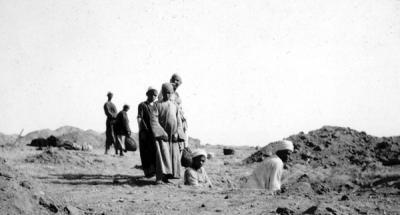British excavations in Egypt 1880-1980: the distributing institutions and their sponsors
From the 1880s onwards British teams were prolific exporters of Egyptian antiquities, in large measure due to its position as an occupying power from 1882 until 1952. In 1883 Flinders Petrie negotiated new terms of ‘partage’ with Gaston Maspero, Head of the French-run Service du Antiquités de l’Égypte an agreement that permitted archaeologists to legally export a share of their finds for distribution, following the Museum in Cairo’s first selection. The ‘partage’ model was underpinned by a complex system of financial sponsorship, sometimes arranged with the support of a few private individuals, but most frequently via a handful of British organizations:
- Egypt Exploration Fund (EEF), 1883–1915
- Egypt Exploration Fund (EFF): Graeco Roman Branch
- Egypt Exploration Fund/Hellenic Society
- Egypt Exploration Society (EES), 1919–present
- Flinders Petrie Independent Excavations, 1887–1892
- Egyptian Research Account (ERA), 1893–1905
- British School of Archaeology in Egypt (BSAE), 1905–1953
- British Museum, 1928–1931
- Byzantine Research and Publication Fund
- Jesse Haworth and Martyn Kennard
- William George Compton, 5th Marquess of Northampton
- Royal Anthropological Society 1927–1928
- University of Liverpool Institute of Archaeology, 1902–1909
- University of Oxford Excavations in Nubia, 1910–1913, 1929–1931, 1934–19
- Sir Robert Mond
The EEF/EES, BSAE, ERA and Liverpool all dispersed objects to institutions following each field season, the extent of which vaired between 1880 and 1980 as antiquities laws and partage agreements changed. Although private individuals could sponsor missions, it was museums that were the primary beneficiaries. In deciding how to divide up finds some of these organizations would consider the demographic profile of individual subscriptions and if there appeared to be a strong regional concentration of donations then the local museum would benefit. Museums were also able to subscribe directly to these organisations in order to secure desirable objects. Universities and schools were similarly considered to be appropriate recipients of antiquities, although in these cases the institutions that benefitted were largely influenced by inter-personal networks. Very occasionally private individuals received small numbers of what were considered to be ‘duplicate’ or less valuable objects for their own private collections, although often these too later percolated into museums.

الحفائر البريطانية في مصر 1880-1980: المؤسسات القائمه علي توزيع القطع الأثرية من الحفائر والجهات الراعية لها:
منذ ثمانينيات القرن التاسع عشر فصاعدا كانت البعثات الأثرية البريطانية مصدرة للأثار المصرية علي نطاق واسع وذلك لكونها قوة احتلال منذ عام 1882 وحتى عام 1952. في 1883 قام فليندرز بيتري بالتفاوض على شروط جديدة لتقسيم الآثار مع غاستون ماسبيرو، رئيس مصلحة الآثار المصرية أنذاك وقد كانت المصلحة مداره من قبل الفرنسيين. وسمحت تلك الإتفاقية لعلماء الآثار بتصدير حصة من الأكتشافات بشكل قانوني لتوزيعها، مع احتفاظ المتحف المصرى في القاهره بأولوية الأختيار. وقد تم دعم نموذج 'التقسيم' من خلال نظام معقد للرعاية المالية، تم تنسيقه في بعض الأحيان بدعم من عدد قليل من الأفراد، ولكن في معظم الأحيان من خلال حفنة من المنظمات البريطانية:
- صندوق إستكشاف مصر ، 1883-1915
- صندوق إستكشاف مصر: الفرع اليوناني الروماني
- صندوق إستكشاف مصر / الجمعية اليونانية
- جمعية إستكشاف مصر ، 1919 إلى الوقت الحاضر
- حفريات فلندرز بيتري المستقلة، 1887-1892
- حساب الأبحاث المصري، 1893-1905
- المدرسة البريطانية للآثار في مصر، 1905-1953
- المتحف البريطاني، 1928-1931
- الصندوق البيزنطي للبحوث والنشر
- جيسي هاورث ومارتن كينارد
- وليام جورج كومبتون، المركيز الخامس لنورثهامبتون
- الجمعية الأنثروبولوجية الملكية 1927-1928
- معهد آثار جامعة ليفربول ، 1902-1909
- حفائر النوبة التابعه لجامعة أكسفورد ، 1910-1913، 1929-1931، 1934-1919
- السير روبرت موند
قام كل من صندوق إستكشاف مصر و جمعية إستكشاف مصر و المدرسة البريطانية للآثار في مصر و معهد آثار جامعة ليفربول بتقسيم القطع الأثرية على المؤسسات المختلفه بعد كل موسم ميداني، وقد تفاوت حجم القطع الأثرية الموزعة بين 1880 و 1980 وفقا لتغير قوانين الآثار واتفاقيات التقسيم بين حين وأخر. وعلى الرغم من أن الأفراد كان بامكانهم رعاية البعثات، فإن المتاحف كانت هي المستفيد الرئيسي. فعند البت في كيفية التقسيم، كانت بعض هذه المنظمات تأخذ في عين الأعتبار الملف الديموغرافي للأشتراكات الفردية، وإذا كان هناك تمركز إقليمي قوي للتبرعات، كان يقع الأختيار علي المتحف المحلي ليكون المستفيد الأول من التوزيع. وتمكنت المتاحف أيضا من الأشتراك مباشرة في هذه المنظمات من أجل تأمين القطع التي ترغب بها. وقد اعتبرت الجامعات والمدارس كذلك متلقين مناسبين للقطع الأثرية من المتاحف. هذا وقد أثرت شبكة العلاقات الشخصية بشكل كبيرعلي تحديد المؤسسات المستفيده من عملية التوزيع. احيانا ما تلقى بعض الأفراد أعدادا صغيرة من القطع الأثرية التي اعتبرت "مكررة" أو "أقل قيمة" لضمها لمجموعاتهم الخاصة، وغالبا ما أنتهت هذه المجموعات الخاصة من القطع الأثرية بالمتاحف الأقليمية بالمملكة المتحدة.
